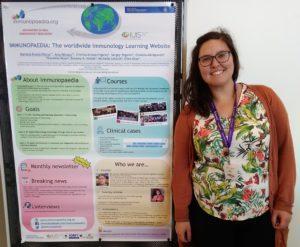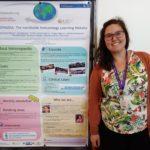
Amy Mónaco presenting a poster about Immunopaedia mission and goals. Highlighting the courses availables, the ambassador program and other immunology content on our website
From 6 to 9 April 2019, the XIII World Immune Regulation Meeting (WIRM) was hosted in Davos, Switzerland. The congress gathered top class worldwide researchers in basic and clinical immunology as well as eager students who presented their latest results on immune activation, effector functions and immune tolerance.
Highlights of the summit include an amazing talk by Prof. Ido Amit who described the challenges associated with the study of individual cells in a heterogeneous populations and how to overcome them with single cell genomics. Definitely single cell analyses were the vedettes in this event and promise to be ground-breaking technique that will be useful in every field. For example, Dr. Massimiliano Pagani used it to dissect the multicellular ecosystem of metastatic melanoma in patient derived organoids (or “tumoroids”), describing tumor infiltrating regulatory T cells (Tregs) as a very precise prognosis biomarker. Likewise, Prof. Lukas Flatz gave a talk about the mechanisms of efficacy/toxicity of checkpoint inhibitors in cancer patients and revealed that the “tumor to tissue similarity” is to blame for the toxicity, but is also a sign of good responders.
Other interesting talks were on the impact of circadian rhythms or the long term impact of early life microbiota on the immune system. Dr. Christoph Scheiermann how the circadian rhythm affectsoscillations in circulating leukocyte counts that are explained by their recruitment to tissues, highly influenced by the central nervous system, and the implications in the course of treatments. Strikingly, tumor burden is time-of-the-day dependent, to be taken into account when designing experiment schedules. Dr. Yasmine Belkaid talked about how S. epidermidis, part of the skin commensal bacteria, induces CD8+ T cells that not only promote antimicrobial defence but also tissue repair. Even topical application of commensal derived antigens as 5-OP-RU (derived from the riboflavin metabolic pathway) promotes MAIT accumulation within dermis 2 weeks later and punch biopsies repair better. Dr. Marianne Spalinger, a postdoctoral research fellow at the University of Zurich, showed amazing results where supplementation with butyrate producing bacteria drastically reduces tumor load in a mouse model of colorectal carcinoma, a function mediated by T cells. Last but not least Dr. Francesca Ronchi, postdoctoral research fellow at the University of Bern, dictated a workshop where she correlated a balanced intestinal microbiota with central nervous system homeostasis.
We also had the privilege to attend to the “Meet the Expert” session, where Prof. David Wraith (Professor of Immunology at the University of Birmingham and CSO of Apitope International NV) gave us advice on whether “to spin or not to spin”, regarding to life after academia. His main recommendations were to “learn bioinformatics, be bold and study human immunology”, and to be aware of the time delay in translation research and emphasise the need to raise funds.
Definitely, attending the WIRM was an excellent opportunity to hear the immunology breaking news right from the source, and to connect with young immunologists like us, establishing collaborative networks around the globe.
Article by Amy Mónaco
